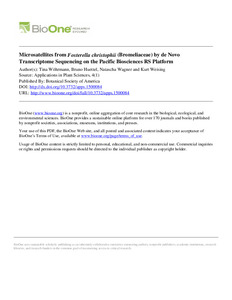| dc.date.accessioned | 2016-02-05T10:26:05Z | |
| dc.date.available | 2016-02-05T10:26:05Z | |
| dc.date.issued | 2016 | |
| dc.identifier.issn | 2168-0450 | |
| dc.identifier.uri | urn:nbn:de:hebis:34-2016020549834 | |
| dc.identifier.uri | http://hdl.handle.net/123456789/2016020549834 | |
| dc.description.sponsorship | Gefördert durch den Publikationsfonds der Universität Kassel | |
| dc.language.iso | eng | |
| dc.rights | Urheberrechtlich geschützt | |
| dc.rights.uri | https://rightsstatements.org/page/InC/1.0/ | |
| dc.subject.ddc | 580 | |
| dc.title | Microsatellites from Fosterella christophii (Bromeliaceae) by de novo transcriptome sequencing on the Pacific Biosciences RS platform | eng |
| dc.type | Aufsatz | |
| dcterms.abstract | • Premise of the study: Microsatellite markers were developed in Fosterella christophii (Bromeliaceae) to investigate the genetic diversity and population structure within the F. micrantha group, comprising F. christophii, F. micrantha, and F. villosula. • Methods and Results: Full-length cDNAs were isolated from F. christophii and sequenced on a Pacific Biosciences RS platform. A total of 1590 high-quality consensus isoforms were assembled into 971 unigenes containing 421 perfect microsatellites. Thirty primer sets were designed, of which 13 revealed a high level of polymorphism in three populations of F. christophii, with four to nine alleles per locus. Each of these 13 loci cross-amplified in the closely related species F. micrantha and F. villosula, with one to six and one to 11 alleles per locus, respectively. • Conclusions: The new markers are promising tools to study the population genetics of F. christophii and to discover species boundaries within the F. micrantha group. | eng |
| dcterms.accessRights | open access | |
| dcterms.bibliographicCitation | In: Applications in plant sciences. - Washington, DC : BioOne, 2016, 4 (1):1500084, 1-4 | |
| dcterms.creator | Wöhrmann, Tina | |
| dcterms.creator | Huettel, Bruno | |
| dcterms.creator | Wagner, Natascha | |
| dcterms.creator | Weising, Kurt | |
| dc.relation.doi | doi:10.3732/apps.1500084 | |

